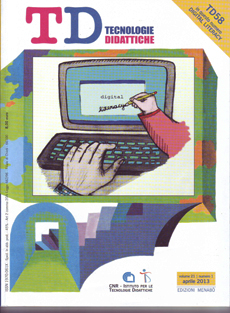Qual'è il senso delle tecnologie nella scuola? Una "road map" per decisori ed educatori
Contenuto principale dell'articolo
Abstract
Dettagli dell'articolo
Sezione
Gli autori che pubblicano su questa rivista accettano le seguenti condizioni:
- Gli autori mantengono i diritti sulla loro opera e cedono alla rivista il diritto di prima pubblicazione dell'opera, contemporaneamente licenziata sotto una Licenza Creative Commons CC BY 4.0 Attribution 4.0 International License.
- Gli autori possono aderire ad altri accordi di licenza non esclusiva per la distribuzione della versione dell'opera pubblicata (es. depositarla in un archivio istituzionale o pubblicarla in una monografia), a patto di indicare che la prima pubblicazione è avvenuta su questa rivista.
- Gli autori possono diffondere la loro opera online (es. in repository istituzionali o nel loro sito web) prima e durante il processo di submission, poiché può portare a scambi produttivi e aumentare le citazioni dell'opera pubblicata (Vedi The effect of Open Access).
Riferimenti bibliografici
Bennett S., Maton K., Kervin L. (2008). The ‘digital natives’ debate. A critical review of the evidence. British Journal of Educational Technology, 39 (6), pp. 775-786.
Bernard R.M., Abrami P.C., Lou Y., Borokhovski E., Wade A., Wozney L., Wallet P.A., Fiset M., Huang B. (2004). How does distance education compare with classroom instruction? A meta-analysis of the empirical literature. Review of Educational Research, 74 (3), pp. 379-439.
Brand-Gruwel S., Wopereis I., Vermetten Y. (2005). Information problem solving by experts and novices: Analysis of a complex cognitive skill. Computers in Human Behavior, 21, pp. 487- 508.
Bruni F. (2009). Blog e didattica. Macerata, IT: Eum.
Burgstahler S. (2003). The role of technology in preparing youth with disabilities for postsecondary education and employment. Journal of Special Education Technology. 18 (4), pp. 7-19.
Calvani A, Fini A., Ranieri M, Picci. P. (2011). Are young generations in secondary school digitally competent? A study on Italian teenagers. Computers & Education, 58, pp.797-80.
Carr N.(2011). Internet ci rende stupidi? Come la rete sta cambiando il nostro cervello. Milano, IT: Cortina.
Chen S.Y., Fan J.P., Macredie R.D. (2006). Navigation in hypermedia learning systems: experts vs. novices. Computers in Human Behavior, 22 (2), pp. 251-266.
Clark R.C., Nguyen F., Sweller J. (2006). Efficiency in learning: Evidence-based guidelines to manage cognitive load. San Francisco, CA, USA: Pfeiffer.
Csikszentmihalyi M. (1992). Flow, the Psychology of Happiness. London, UK: Rider.
Cuban L. (1986). Teachers and machines. The classroom use of technologies since 1920. New York, USA: Teachers College Press.
Cullen J. (2007). Status of e-inclusion measurement, analysis and approaches for improvement, Final Report EU. Brussels, BE: European Commission.
EU (2006). Recommendation the European Parliament and the Council of 18th December 2006 on Key Competences for Lifelong Learning. Official Journal of the European Union (2006/962/EC), L394/10-18.
Fedeli L. (2012). Social media e didattica, Opportunità, criticità e prospettive. Lecce, IT: Pensa Multimedia.
Gui M. (2012). Uso di Internet e livelli di apprendimento. Una riflessione sui sorprendenti dati dell’indagine Pisa 2009. Media Education, Studi, Ricerche, Buone pratiche, 3 (1), pp. 29-42.
Hattie J. (2009). Visible learning: A synthesis of over 800 meta-analyses relating to achievement. London, New York: Routledge.
Hattie J. (2012). Visible learning for teachers: Maximizing impact on learning. London and New York: Routledge.
Kirschner P.A., Sweller J.E., Clark R.E. (2006).Why minimal guidance during instruction does not work: An analysis of the failure of constructivist, discovery, problem-based, experiential, and inquiry- based teaching. Educational Psychologist, 41 (2), 75–86.
Kozma R. (1994). Will media influence learning: reframing the debate. Educational Technology Research and Development, 42 (2), pp. 7-19.
Margaryan A., Littlejohn A. (2008). Are digital natives a myth or reality?. Students’ use of technologies for learning. http://www.academy.gcal.ac.uk/anoush/documents/ DigitalNativesMythOrReality-MargaryanAndLittlejohn- draft-111208.pdf (ultima consultazione 22.08.2012).
Martin S.S. (2005). Special education, technology and teacher education, http://site.aace.org/pubs/foresite/SpecialEducation. pdf (ultima consultazione 22.08.2012).
Mayer R.E. (2004). Should there be a three-strikes rule against pure discovery learning? The case for guided method of instruction. American Psychologist, 59 (1), pp. 14-19.
OECD (2011). PISA 2009 Results: students on line: digital technologies and performance,VI. Paris: OECD.
Ong W. (1986). Oralità e scrittura. Le tecnologie della parola. Bologna, IT: Il Mulino.
Ranieri M. (2011). Le insidie dell’ovvio. Tecnologie educative e critica della retorica tecnocentrica. Pisa, IT: ETS.
Russell T.L. (1999). No significant difference phenomenon. Raleigh, NC, USA: North Carolina State University.
Salomon G., Perkins D. N., Globerson T. (1991). Partners in Cognition: Extending human intelligence with intelligent technologies. Educational Researcher, 20 (3), pp. 2-9.
Small G., Vorgan G. (2008). Ibrain: surviving the technological alteration of the modern mind. New York, USA: Collins.
Thomas D., Brown J.S. (2011). A new culture of learning. Cultivating the imagination for a world of constant change. Lexington, KY, USA: Create- Space.

